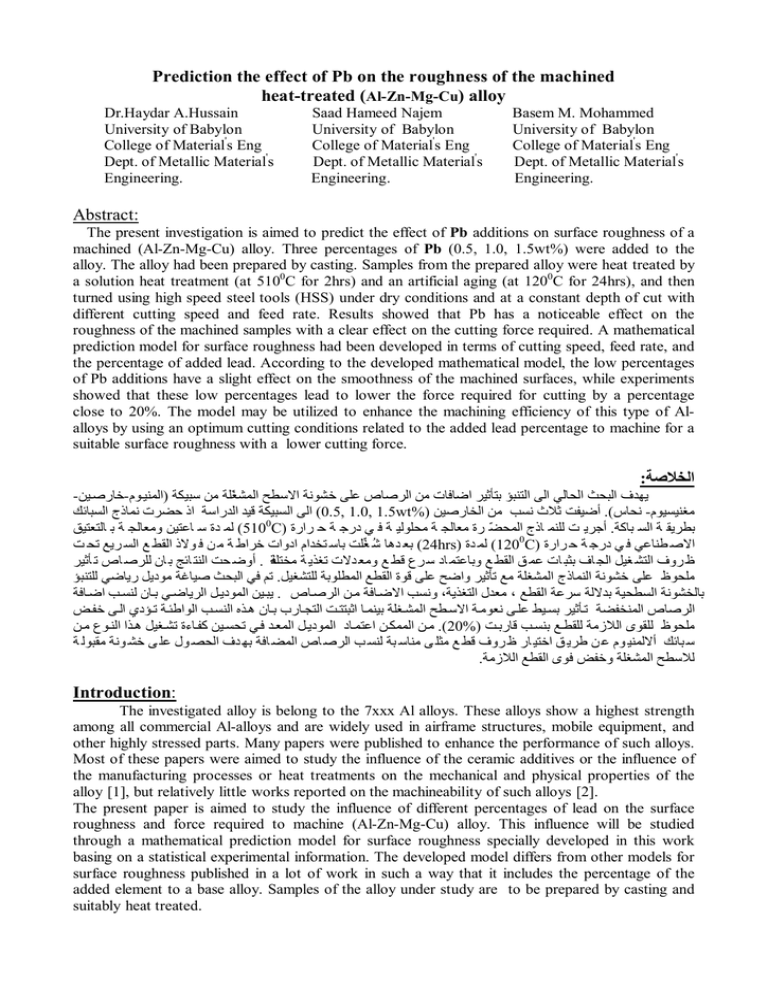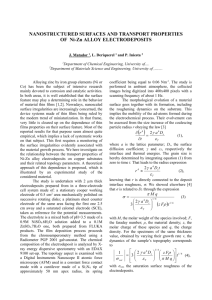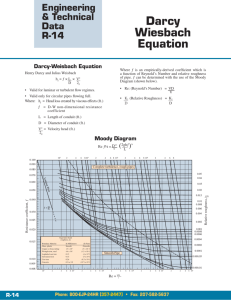Prediction the effect of Pb on the roughness of the... heat-treated ( ) alloy
advertisement

Prediction the effect of Pb on the roughness of the machined heat-treated (Al-Zn-Mg-Cu) alloy Dr.Haydar A.Hussain University of Babylon College of Material's Eng Dept. of Metallic Material's Engineering. Saad Hameed Najem University of Babylon College of Material's Eng Dept. of Metallic Material's Engineering. Basem M. Mohammed University of Babylon College of Material's Eng Dept. of Metallic Material's Engineering. Abstract: The present investigation is aimed to predict the effect of Pb additions on surface roughness of a machined (Al-Zn-Mg-Cu) alloy. Three percentages of Pb (0.5, 1.0, 1.5wt%) were added to the alloy. The alloy had been prepared by casting. Samples from the prepared alloy were heat treated by a solution heat treatment (at 5100C for 2hrs) and an artificial aging (at 1200C for 24hrs), and then turned using high speed steel tools (HSS) under dry conditions and at a constant depth of cut with different cutting speed and feed rate. Results showed that Pb has a noticeable effect on the roughness of the machined samples with a clear effect on the cutting force required. A mathematical prediction model for surface roughness had been developed in terms of cutting speed, feed rate, and the percentage of added lead. According to the developed mathematical model, the low percentages of Pb additions have a slight effect on the smoothness of the machined surfaces, while experiments showed that these low percentages lead to lower the force required for cutting by a percentage close to 20%. The model may be utilized to enhance the machining efficiency of this type of Alalloys by using an optimum cutting conditions related to the added lead percentage to machine for a suitable surface roughness with a lower cutting force. : - - ) (0.5, 1.0, 1.5wt%) .( . (5100C) - (1200C) (24hrs) . . . .(20%) . Introduction: The investigated alloy is belong to the 7xxx Al alloys. These alloys show a highest strength among all commercial Al-alloys and are widely used in airframe structures, mobile equipment, and other highly stressed parts. Many papers were published to enhance the performance of such alloys. Most of these papers were aimed to study the influence of the ceramic additives or the influence of the manufacturing processes or heat treatments on the mechanical and physical properties of the alloy [1], but relatively little works reported on the machineability of such alloys [2]. The present paper is aimed to study the influence of different percentages of lead on the surface roughness and force required to machine (Al-Zn-Mg-Cu) alloy. This influence will be studied through a mathematical prediction model for surface roughness specially developed in this work basing on a statistical experimental information. The developed model differs from other models for surface roughness published in a lot of work in such a way that it includes the percentage of the added element to a base alloy. Samples of the alloy under study are to be prepared by casting and suitably heat treated. Experimental Details: Experimental part includes: preparation of samples of the investigated alloy by casting in metallic die; processes regarding heat treatments of the prepared alloys, processes regarding hardness tests; and processes regarding machining tests (samples preparation, surface roughness tests, and cutting force tests). - Melting and casting process: The raw materials from which the alloys will be consisted were melted in a gas furnace by using ceramic crucible. The prepared alloys are listed in table (1). The crucible was preheated and a part of the required amount of aluminum was melted, then powders of alloying elements (Cu, Zn, Mg, Pb) coated by an aluminum foil were added according to their melting point starting from the higher one. The melt was mixed by a graphite rod for enough time after each addition. Finally the remaining part of aluminum was added. The melt was poured rapidly in a steel die having a cylindrical cave of 5cm diameter and a height of 20cm. - Heat treating of the samples: Firstly the samples were homogenized for 24 hours at 5000C in a furnace type (Sola Basic S.B Lindberg) working in a range of (200-12000C), and then they were cooled slowly to room temperature. The samples then were heated for 2 hours at 5100C and quenched in cooled water at 00C for a solution heat treatment. An artificial aging of the samples was carried out by heating them for 24 hours at 1200C. The mentioned above heat treatment were carried out to get the higher strength and hardness for the investigated alloy [1,2]. - Hardness test: Samples from the alloys (heat treated) were prepared for this test. The tests were carried out using a hardness tester type (Microhardness Tester, China, HV-1000). - Machining tests: External turning was used for all experiments. The experiments were achieved on a lathe machine (Harison/England) with a power of 2.2KW and speed of (40-2500 rpm) and feed rate of (0.03-1 mm/rev.). Samples from the investigated alloys was prepared in a cylindrical form and divided with the dimensions shown in fig. (1). The cutting tests had been carried out using tools made of high speed steel with a chemical composition of (18.5%W, 1.4%V, 1%Mo, 4.4%Cr, 0.5%Co, 0.83%C, and Fe) and a rake angle of 50 and a nose radius of 0.8mm. Dry cutting condition was used at a constant depth of cut (d = 0.5mm). Four spindle speeds (260, 370, 540, 800 rpm) for each of which two feed rates (0.03, 0.05 mm/rev.) were used in these tests. Surface roughness measurements were made using the Taylor Hanson surface roughness measuring instrument. The average of three values of the surface roughness was considered as a result for each experiment. Special designed instrument was used to measure the vertical deflection of the cutting tool during machining operation. The values of the deflection were considered as a reflection of the main cutting force. Table (2) shows the cutting conditions, the measured surface roughness and the measured values of the tools deflection. Mathematical Model: In any turning operation, where the effects of friction, vibration, build-up edge (BUE) are neglected, the surface roughness will largely be the marks left on the workpiece by the used tool as a result of the feed, nose radius, and the cutting speed. For a given tool the mathematical model which relates the effect of these independent variables on the surface roughness of the cutting operation can take the following forms [3,4]: Ra = aV b f c Ra = aV b f c r d or (1) Where Ra is the surface roughness ( m), while V is the cutting speed (m/min.), f (mm/rev) is the feed rate, and r-the tool nose radius. The presented investigation introduces a new factor, Pb% - the percentage of the added lead, which reflects its influence on the surface roughness, so the following form of a mathematical model may be reliable to predict this influence: d Ra = aV b f c (Pb %) (2) The constants of the above model (a, b, c, and d) were determined by using the method of least squares, so the surface roughness can be provided as follows: Ra = 175.34V −0.3158 f 1.093 (Pb %) 0 , 0397 (3) This model is valid for turning the investigated alloy using the mentioned type of a high speed steel tool under dry cutting conditions with a depth of cut equals 0.5 and a nose radius of 0.8mm. Equation (3) indicates that an increase in the cutting speed decreases the surface roughness while an increase in the feed rate increases the surface roughness which coincident with many other works [5,6]. The mathematical model given by Eq.3 was tested by the analyses of regression with a coefficient of determination equals to 0.809. Fig.2 shows that the predicted values of the surface roughness are a close match of its experimental values. By using the developed mathematical model of the surface roughness, contours of selected values of surface roughness in cutting speed-feed rate plane is plotted in fig. (4). The represented, in fig.(4), values of the surface roughness are calculated for a 0.05%Pb additive. This will give a good ability to select an optimum combination of feed and cutting speed without increasing the surface roughness. Results and discussion : The results of the hardness tests are listed in table (1) and that of the surface roughness and the tool’s deflection are demonstrated in table (2) and fig.3. The results show the following: - In general, the Pb additives affect the mechanical properties (hardness and strength) of the alloy in such away that this affect is proportional to the percentage of the added Pb. This may belong to the fact that a soft metal, lead in this case, will precipitate at the grain boundary of the base alloy causing its softening. So the deflection of the cutting tool reduces with the added Pb. This means that the added Pb reduces the cutting force required to machine the alloy. - Also, in the same behavior the added Pb increases the roughness of the machined surfaces of the alloy. This is due to the increased amount of friction between the tool and the softened (by the added Pb) surface and between the cut chip and the tool face. Conclusions: - - Conclusions may be summarized as following: An enhancement in machining the investigated alloy can be approached by adding a very small percentage of Pb to its chemical composition, specially when the effect of such percentage on the hardness and the strength of the alloy can be ignored. The results indicate that the small percentage of the added Pb (namely 0.05%) has a little influence on the surface roughness, but it reduces the cutting force by a percentage close to 20%. - The developed model may be utilized to enhance the machining efficiency of this type of Al- alloys by using an optimum cutting conditions related to the added lead percentage to machine for a suitable surface roughness with a lower cutting force. References: 1- Kon Bae Lee and Hoon Kwoon, (2002), Strength of Al-Zn-Mg-Cu Matrix Composite Reinforced with Sic Particles, Metallurgical and Materials Transactions, V33A, 455-465. 2- Rashad R. M., El-Hossainy T. M., (2006), Machinability of 7116 Structural Aluminum Alloy, Materials and Manufacturing Processes, Volume 21, Issue 1 January, pages 23-27. 3- Feng C.-X., Yu Z., and Andrew K., 2006, Selection and validation of predictive regression and neutral network models based on designed experiments, IIE Transactions, 38, 13-23. 4- Da Silva M. B.and Wallbank J., 1999, Surface Finish and Lubricating at Low Speeds, Materials Science and Technology, Vol.15, P(221-225). 5- EI Baradie M. A., 1993, Surface Roughness Model for Turning Grey Cast Iron (154BHN), Journal of Engineering Manufacture, Vol 207, P (43-54). 6- Haydar A.H., Mushtaq T. A., (2008), Methodology for assessment of turning using carbides, Journal of Babylon University, V15, No.1, 386-391. Table (1): Chemical composition and hardness of the heat treated samples. Weight percentage of elements (%) HV hardness (kg/mm2) Alloy code Al Zn Mg Cu Pb Homogenized 5000C, 120hrs. A Balance 6.1 2.9 2 ------ 100 Solution heat treatment 5100C, 2hrs. 80 B Balance 6.1 2.9 2 0.5 95 75 105 C Balance 6.1 2.9 2 1.0 90 78 100 D Balance 6.1 2.9 2 1.5 86 78 98 Artificial aging 1200C, 24hrs. 110 Table (2): Experimental conditions and the resulted surface roughness and tool’s deflection. Alloy code A B C D Spindle speed, rpm 260 370 540 800 260 370 540 800 260 370 540 800 260 370 540 800 Measured roughness Predicted roughness µm µm Tools deflection Feed rate Feed rate Feed rate Feed rate µm 0.03mm/rev. 0.05mm/rev. 0.03mm/rev. 0.05mm/rev. 0.457 0.907 0.417 0.728 0.403 0.577 0.373 0.651 100 0.34 0.49 0.331 0.578 0.33 0.45 0.292 0.51 0.514 1.061 0.585 1.021 0.498 0.827 0.523 0.914 80 0.432 0.776 0.464 0.811 0.412 0.665 0.41 0.716 0.61 1.293 0.659 1.151 0.574 0.938 0.589 1.029 70 0.514 0.926 0.523 0.913 0.498 0.904 0.462 0.807 0.637 1.372 0.669 1.169 0.586 0.981 0.599 1.045 60 0.523 0.948 0.531 0.928 0.504 0.918 0.469 0.82 Fig.(1): Configuration and dimensions of the prepared samples. Fig.2 : Scatter plot of the experimental roughness and its predicted values. Fig.(3): Variation of the surface roughness against the spindle speed a) for f=0.05mm/rev; and b) for f=0.03mm/rev. Fig. (4): Surface roughness in spindle speed-feed rate plane.




